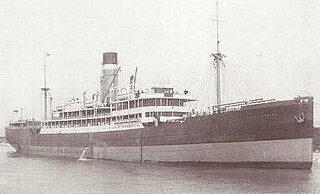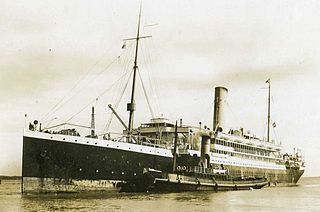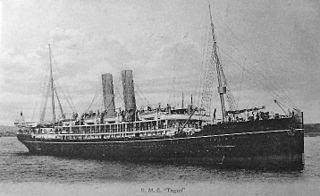
RMS Alcantara was an ocean liner which entered service just weeks before the start of World War I, was converted to an armed merchant cruiser in 1915, and was sunk in combat with the German armed merchant cruiser SMS Greif in the Action of 29 February 1916.

RMS Arlanza was a 14,622 GRT ocean liner of the Royal Mail Steam Packet Company. She was built in Belfast in 1912 for RMSP's scheduled route between England and South America. She was a Royal Navy armed merchant cruiser from 1915 until 1920. She returned to civilian liner service in 1920 and was scrapped in 1938.

RMS Alcantara was a Royal Mail Lines ocean liner that was built in Belfast in 1926. She served in the Second World War first as an armed merchant cruiser and then a troop ship. She returned to civilian service in 1948 and was scrapped in 1958.

RMS Rhone was a UK Royal Mail Ship owned by the Royal Mail Steam Packet Company (RMSP). She was wrecked off the coast of Salt Island in the British Virgin Islands on 29 October 1867 in a hurricane, killing 123 people. She is now a popular Caribbean wreck dive site.

The Royal Mail Steam Packet Company was a British shipping company founded in London in 1839 by a Scot, James MacQueen. The line's motto was Per Mare Ubique. After a troubled start, it became the largest shipping group in the world in 1927 when it took over the White Star Line. The company was liquidated and its assets taken over by the newly formed Royal Mail Lines in 1932 after financial trouble and scandal; over the years RML declined to no more than the name of a service run by former rival Hamburg Süd.

SS City of Venice was an intermediate ocean liner that was launched in 1924 in Northern Ireland for Ellerman Lines. In the Second World War she was a troop ship. In 1943 a U-boat sank her in the Mediterranean, killing 22 of the crew and troops aboard.

RMS Atrato was a UK steamship that was built in 1888 as a Royal Mail Ship and ocean liner for the Royal Mail Steam Packet Company. In 1912 she was sold and became the cruise ship The Viking. Late in 1914 she was requisitioned and converted into the armed merchant cruiser HMS Viknor. She sank in 1915 with all hands, a total of 295 Royal Navy officers and men.
RMS Amazon may refer to one of the following Royal Mail Ships of the Royal Mail Steam Packet Company or Royal Mail Lines:
SS Norwich City was a British cargo steamship. She was built in 1911 as Normanby, and renamed Norwich City in 1919. She was wrecked in the Pacific Ocean in 1929. For many years her wreck was a sea mark on the atoll of Nikumaroro. The wreck is now largely broken up.
RMS Magdalena was a British steamship that was built in 1889 as a Royal Mail Ship and ocean liner for the Royal Mail Steam Packet Company. In the First World War she served as the troop ship HMT Magdalena. After a long and successful civilian and military career she was scrapped in 1923.

RMS Atrato was a UK iron-hulled steamship. She was built in 1853 for the Royal Mail Steam Packet Company as a side-wheel paddle steamer, and at the time of her launch was the world's largest passenger ship. In 1870 RMSP traded Atrato in, causing her to lose the status of "Royal Mail Ship". She was converted to a single screw ship with a compound steam engine in 1872, and placed on the Aberdeen Line that chartered her to run to Victoria and New Zealand. In 1880 she was renamed Rochester before sinking four years later in 1884 by running aground.

HMT Aragon, originally RMS Aragon, was a 9,588 GRT transatlantic Royal Mail Ship that served as a troop ship in the First World War. She was built in Belfast, Ireland in 1905 and was the first of the Royal Mail Steam Packet Company's fleet of "A-liners" that worked regular routes between Southampton and South American ports including Buenos Aires.

RMS Asturias was a Royal Mail Steam Packet Company ocean liner that was built in Ireland in 1908 and scrapped in Japan in 1933. She was a Royal Mail Ship until 1914, when on the eve of the First World War the British Admiralty requisitioned her as a hospital ship.

SS Trent was a British steamship that was built in 1899 as an ocean liner for the Royal Mail Steam Packet Company (RMSP) service between England and the Caribbean. In the First World War she was a Royal Navy depot ship. She was scrapped in 1922.

RMS Amazon was a transatlantic Royal Mail Ship that the Royal Mail Steam Packet Company operated on scheduled services between Southampton and South American ports including Buenos Aires. She was the second of the RMSP's fleet of "A" series liners, and was launched in 1906.

RMS Asturias was a Royal Mail Lines ocean liner that was built in Belfast in 1925. She served in the Second World War as an armed merchant cruiser until she was crippled by a torpedo in 1943. She was out of action until 1948 when she returned to civilian service as an emigrant ship. She became a troop ship in 1954 and was scrapped in 1957.
SS Blitar was a Dutch cargo steamship that was launched in Rotterdam in 1922 and sunk in the Battle of the Atlantic in 1943. She is notable for having fought off three u-boats in succession for nearly ten hours before U-632 finally managed to sink her. 26 of Blitar's complement were killed.
SS Potaro was a refrigerated cargo steamship that was built in Belfast in 1904, and captured and scuttled in the First World War in 1915.
RMS Orinoco was a British Royal Mail Ship that was built in Scotland in 1886 and scrapped, also in Scotland, in 1909. She spent her entire career with the Royal Mail Steam Packet Company (RMSP), mainly trading between England and the Caribbean.
Thomas Richard Pearce (1859–1908), born Thomas Richard Millett, was an Irish ship master in the UK merchant marine. He served his apprenticeship on sailing ships with Aitken & Lilburn's Loch Line, and then rose through the ranks on steamships with the Royal Mail Steam Packet Company (RMSP).















